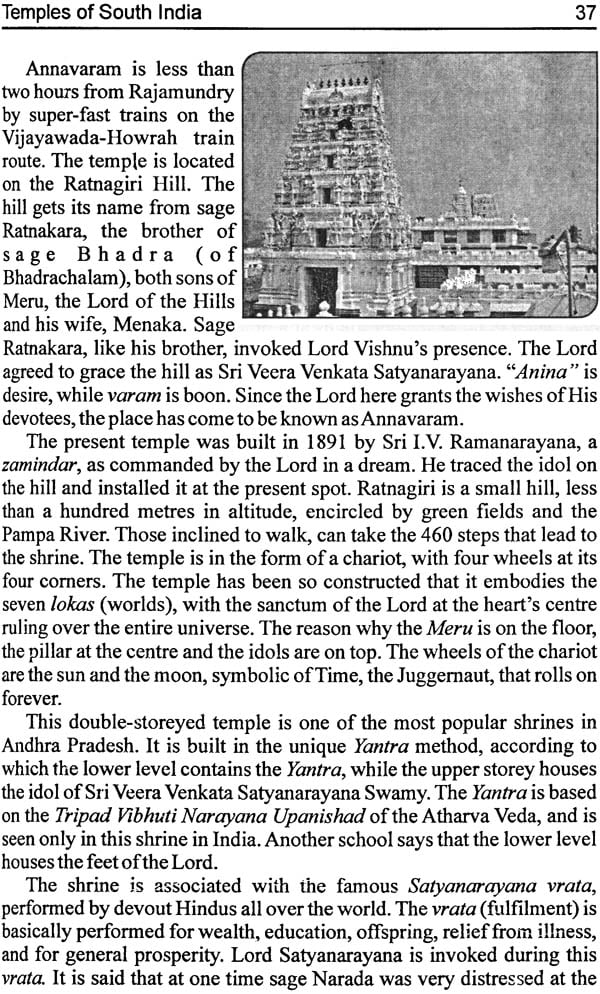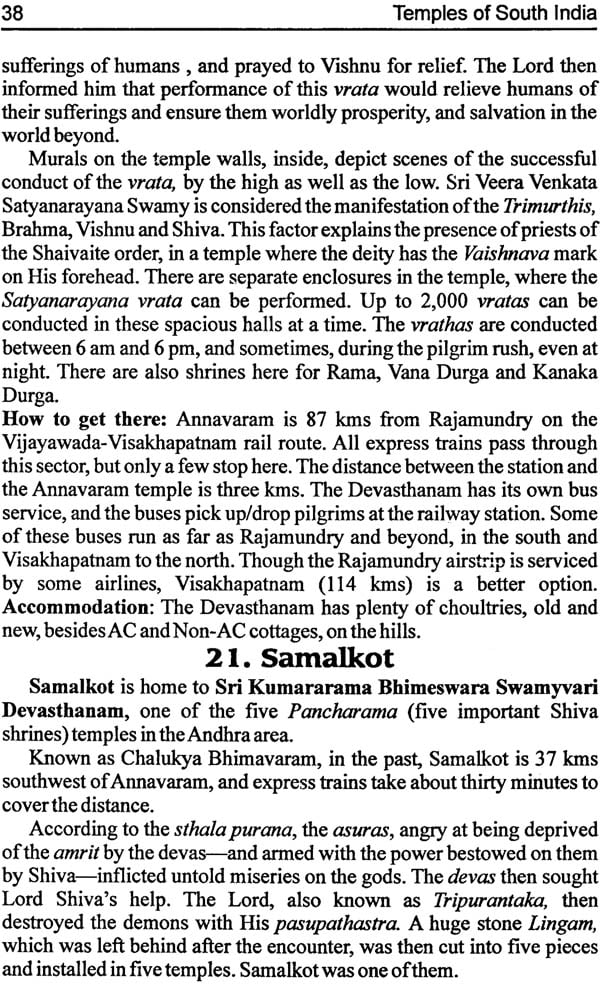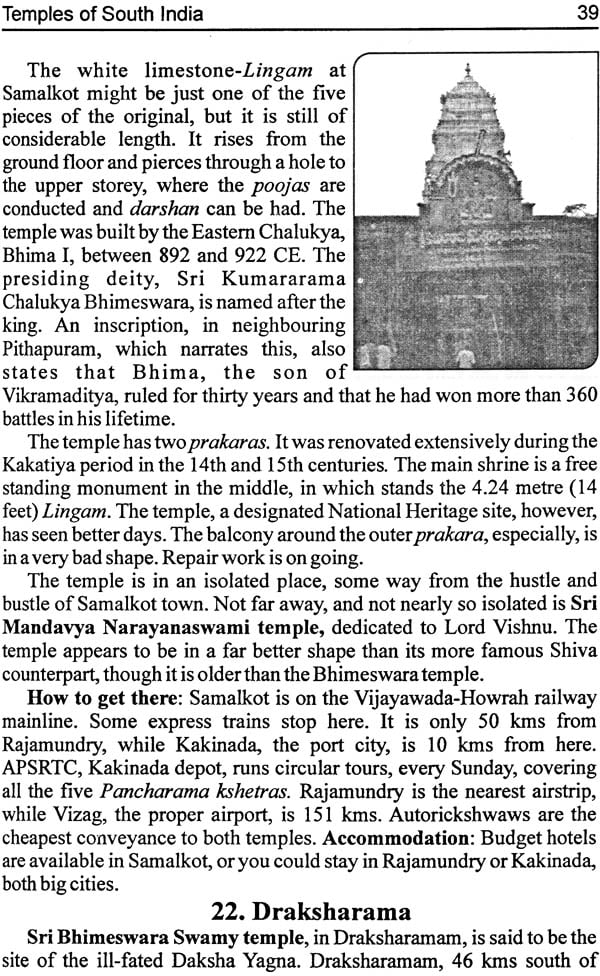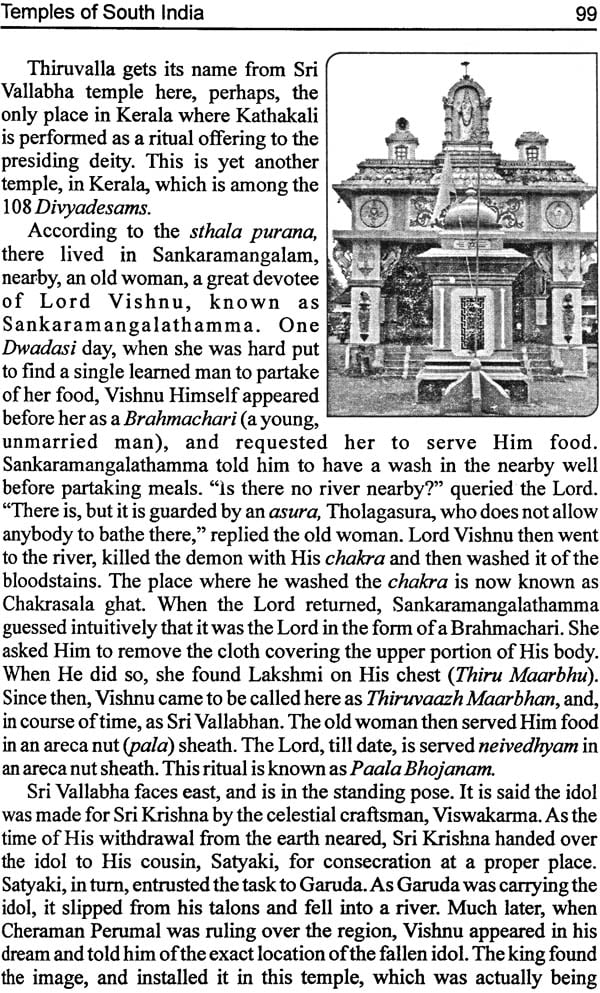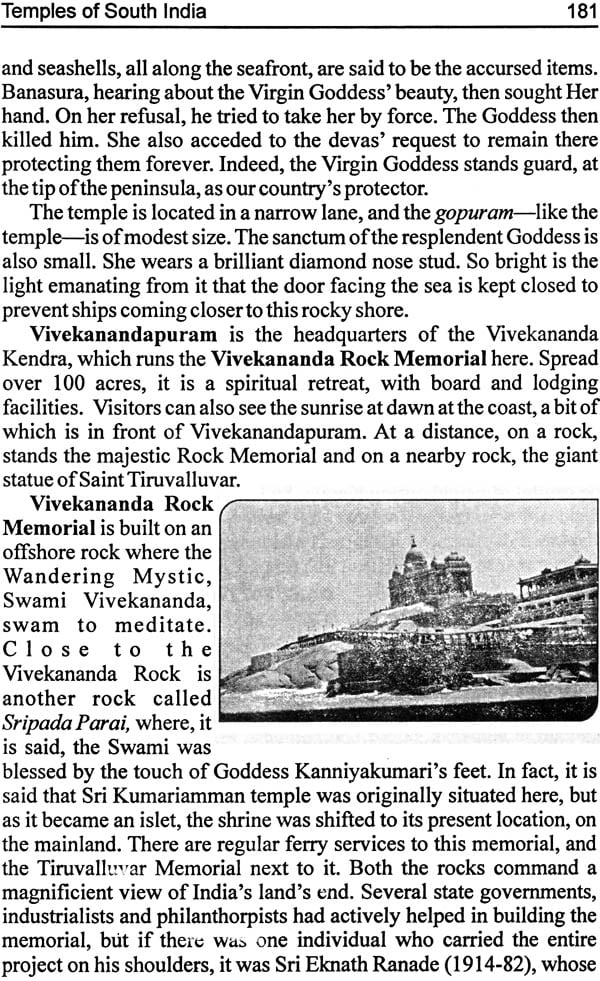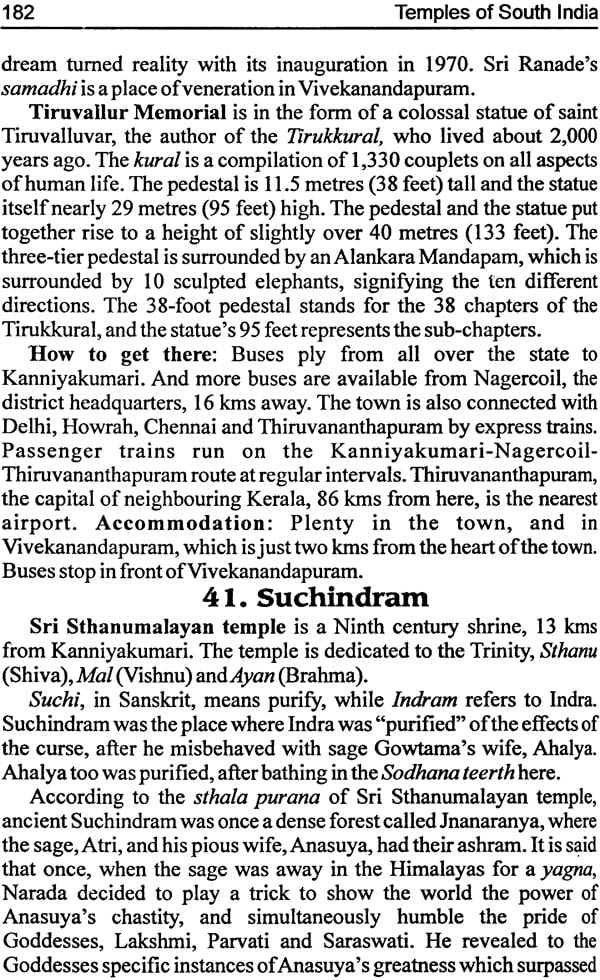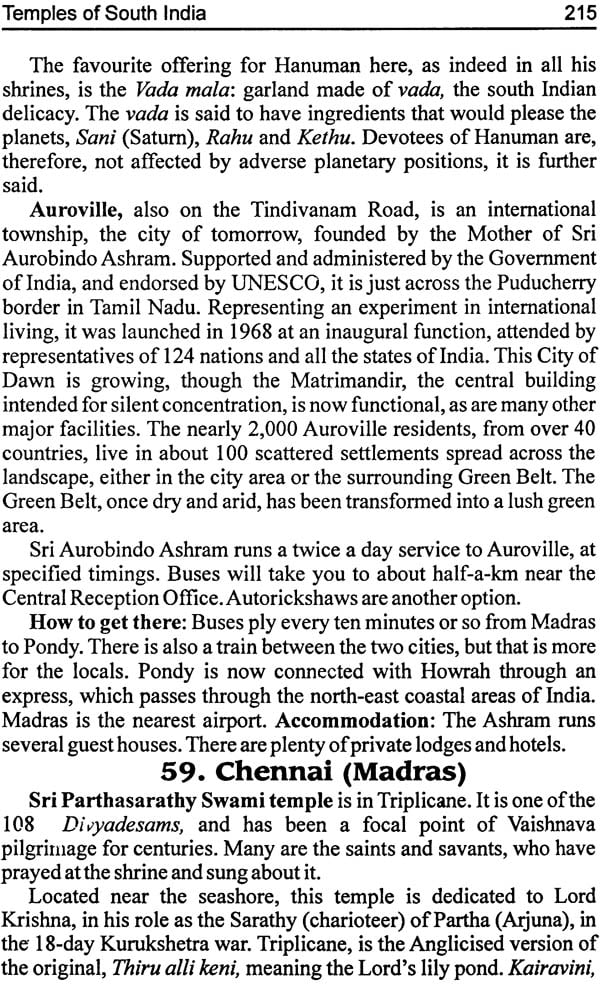
Temples of South India
Book Specification
| Item Code: | NAM329 |
| Author: | Macherla Diwakar |
| Publisher: | Techno Book House, Tamil Nadu |
| Language: | English |
| Edition: | 2015 |
| ISBN: | 9789383440344 |
| Pages: | 224 (150 B/W Illustrations) |
| Cover: | Paperback |
| Other Details | 8.5 inch x 5.5 inch |
| Weight | 250 gm |
Book Description
Hindus can proudly claim to be the descendants of a race that believes in idol worship, in worshipping stones, animals, birds and reptiles. We visit temples with the weirdest and most bizarre sthala puranas, and are not ashamed of it. We are not ashamed of our Naga sadhus either, for they are just another manifestation of the freedom of thought and action that this land is famous for. All this and more represents the inclusiveness of what is popularly known as Hinduism, but which in reality is Sanatana Dharma, the eternal path.
Templeck to 80,000 years. In any case, Rudra, the fierce form of Lord Shiva, is mentioned in the Vedas, which predate the Puranas by a long way.
However, our brief here is not worship can be said to be as old as the hills. Well, not nearly. The hills came first and the temples later. Worship through the medium of stones was the origin, doubtless. Organised worship, in the form of temples, followed in due course. Even the sthala puranas of the various temples only speak of the origin of the idol. To give just one example, the Sri Guruvayurappan idol, in Guruvayur, is stated to be given by Lord Krishna, anticipating the destruction of Dwaraka, to His devotee, Udhava. Udhava then asked for guidance from Brihaspati, the Guru of the Gods, and Vayu, the God of Wind. Guru and Vayu installed the deity, in the presence of Parasurama. Since Guru and Vayu installed the idol, the place came to be known as Guru- Vayuur or oor: place, and the deity as Sri Guruvayurappan. This was just after the advent of Kali Yuga, some 5,000 years ago. The first historical mention of the Guruvayur temple was a good deal later-in the 14th century. However, worship of the idol is slated to have been going on for a much longer period.
Likewise, worship at Sri Dharma Sastha temple in Sabarimala is stated to have begun around 4,500 years back. Similarly, Sri Parthasarathy Swamy temple, in Triplicane, Madras, is first mentioned by Periyalwar, who is said to have lived about 4,000 years ago. In all these cases, the idols came first and the structures later. There are also thousands of instances where monarchs built temples and installed the idols. These are in a different category altogether.
Worship of Shiva goes back even earlier, to the Tretaya Yuga-2, 165,000 years back, if you take the scriptures literally, or 7,200 years ago, according to Yogi Yugteswar Giri (1855-1936), who thinks that the earlier "traditional or long count view is based on a misunderstanding." Be that as it may, tens of temples are strewn across the land where the Shiva Lingam was ostensibly installed by Lord Rama, who lived in the Tretaya Yuga. The most prominent example is Sri Ramanatha Swamy temple in Rameswaram. But this is a point that is likely to be disputed by devout Vaishnavas. Without getting into the Shaiva- Vaishnava controversy, we would like to advert to the Lingam in Sri Vruddha Mallikarjuna Swamy shrine, in Srisailam, which is said to be the oldest entity in Sri Mallikarjuna Swamy/Goddess Brahmaramba Devi temple complex, dating ba to do research about temple worship, but to write about the temples per se. We are glad to say that all the temples––one hundred per cent of them, covered in this book were personally 'visited by the author, during a period spanning slightly more than a year. Trains and mainly buses, were the chosen mode of transport. For three reasons. They are cheap, safe and that is the way ninety per cent of Indians travel.
Hindus can proudly claim to be the descendants of a race that believes in idol worship, in worshipping stones, animals, birds and reptiles, a race whose men wear the holy marks on their bodies, and whose women sport the vermilion mark on their foreheads. We believe in the Vedas and Upanishads, the epics and the numerous puranas. We visit temples with the wierdest and most bizarre sthala puranas, and are not ashamed of it We are not ashamed of our Naga sadhus either, for they are just another manifestation of the freedom of thought and action that this land is famous for. All this and more represents the inclusiveness of what is popularly known as Hinduism, but which in reality is Sanatana Dharma, the eternal path.
The paths are many, but the goal is one, proclaimed the Vedas of our rishis, eons ago. We don't have priests or prophets who order us to read a particular book or follow a particular way of life, or risk excommunication or, worse, death. We have assimilated many religions or at least the worthy practices of other faiths. We were secular long before the word was coined. However, we are now confronted by a grave danger from exclusive religions and their phoney secular friends. The danger to our Sanatana Dharma–temples are just one part of it–is real and clear. But we can take heart from what the great modem rishi, Sri Aurobindo, said: "Hindu culture is not such a weak and fluffy thing as to be easily stamped out; it has lasted through something like five millenniums and is going to carry on much longer and has quite enough power to survive."
| Andhra Pradesh / Telangana | ||
| 1 | Lepakshi | 9 |
| 2 | Vontimitt | 10 |
| 3 | Nandalur | 12 |
| 4 | Brahmamgari Mattam | 12 |
| 5 | Ahobilam | 14 |
| 6 | Mahanandi | 16 |
| 7 | Srisailam | 18 |
| 8 | Alampur (Telangana) | 21 |
| 9 | Tirupati- Tiruchanur | 22 |
| 10 | Tirumala | 23 |
| 11 | Nagari | 25 |
| 12 | Narayanavanam | 26 |
| 13 | Nagalapuram | 27 |
| 14 | Bhadrachalam (Telangana) | 28 |
| 15 | Parnasala(Telangana) | 30 |
| 16 | Dwaraka Tirumala | 31 |
| 17 | Vijayawada | 32 |
| 18 | Rajamundry | 33 |
| 19 | Ryali | 35 |
| 20 | Annavaram | 36 |
| 21 | Samalkot | 38 |
| 22 | Draksharama | 39 |
| 23 | Kotipalli | 41 |
| 24 | Ainavilli | 42 |
| 25 | Mukteswaram | 43 |
| 26 | Appanapalli | 43 |
| 27 | Antarvedi | 44 |
| 28 | Palakkolu | 46 |
| 29 | Bhimavaram | 47 |
| 30 | Srikakulam | 48 |
| 31 | Prasanthi Nilayam | 49 |
| Karnataka | ||
| 1 | Gokarna | 53 |
| 2 | ldagunji | 55 |
| 3 | Murudeshwara | 56 |
| 4 | Kollur | 58 |
| 5 | Udupi | 60 |
| 6 | Karkala | 62 |
| 7 | Sringeri | 63 |
| 8 | Horanadu | 65 |
| 9 | Dharmasthala | 66 |
| 10 | Belur | 68 |
| 11 | Halebidu | 70 |
| 12 | Belavadi | 72 |
| 13 | Shravanabelagola | 73 |
| 14 | Srirangapattana | 75 |
| 15 | Sri Chamundi Hills | 76 |
| 16 | Bengaluru | 78 |
| 17 | Nanjangud | 80 |
| 18 | Somanathpur | 82 |
| Kerala | ||
| 1 | Thiruvananthapuram | 85 |
| 2 | Thrissur | 86 |
| 3 | Guruvayur | 88 |
| 4 | Mammiyur | 90 |
| 5 | Sabarimala | 91 |
| 6 | Ambalapuzha | 93 |
| 7 | Chengannur | 95 |
| 8 | Aranmula | 97 |
| 9 | Thiruvalla | 98 |
| 10 | Chottanikkara | 101 |
| 11 | Kalady | 103 |
| 12 | Kozhikode | 105 |
| 13 | Pulpally | 106 |
| Tamil Nadu | ||
| 1 | Chidambaram | 110 |
| 2 | Gangaikonda Cholapuram | 112 |
| 3 | Tiruvannamalai | 113 |
| 4 | Tiruvallur | 116 |
| 5 | Tiruvottiyur | 117 |
| 6 | Tiruvanmiyur | 119 |
| 7 | Tiruvaiyaru | 120 |
| 8 | Thingalore | 122 |
| 9 | (Raja) Mannargudi | 123 |
| 10 | Tirukkandiyur | 124 |
| 11 | Thanjavur | 126 |
| 12 | Swamimalai | 128 |
| 13 | Thiruvalanchuzhi | 129 |
| 14 | Patteswaram | 130 |
| 15 | Darasuram | 132 |
| 16 | Oppiliappan Kovil | 133 |
| 17 | Tirunageswaram | 135 |
| 18 | Kumbakonam | 137 |
| 19 | Kanchipuram | 139 |
| 20 | Kundrathur | 146 |
| 21 | Tiruchi | 147 |
| 22 | Jambukeswaram | 149 |
| 23 | Srirangam | 151 |
| 24 | Samayapuram | 153 |
| 25 | Pillayarpatti | 154 |
| 26 | Kundrakudi | 156 |
| 27 | Rameswaram | 157 |
| 28 | Madurai | 159 |
| 29 | Tirupparankundram | 162 |
| 30 | Koodal Azhagar | 163 |
| 31 | Alagar Kovil | 165 |
| 32 | Pazhamuthircholai | 166 |
| 33 | Srivilliputhur | 168 |
| 34 | Tenkasi | 170 |
| 35 | Kuttralam | 172 |
| 36 | Sankarankovil | 173 |
| 37 | Tiruchendur | 174 |
| 38 | Krishnapuram | 177 |
| 39 | Tirunelveli | 178 |
| 40 | Kanniyakumari | 180 |
| 41 | Suchindram | 182 |
| 42 | Palani | 185 |
| 43 | Sri Masaniamman Kovil | 187 |
| 44 | Marudhamalai | 188 |
| 45 | Perur | 190 |
| 46 | Dhyanalinga | 191 |
| 47 | Bannari | 192 |
| 48 | Avinashi | 194 |
| 49 | Tirumurugan Poondi | 196 |
| 50 | Bhavani | 198 |
| 51 | Tiruchengode | 200 |
| 52 | Salem | 201 |
| 53 | Tharamanalam | 203 |
| 54 | Sirkazhi | 205 |
| 55 | Vaitheeswarankoil | 206 |
| 56 | Tirukkadaiyur | 208 |
| 57 | Tiruttani | 210 |
| 58 | Puducherry (Pondicherry) | 212 |
| 59 | Chennai (Madras) | 215 |

